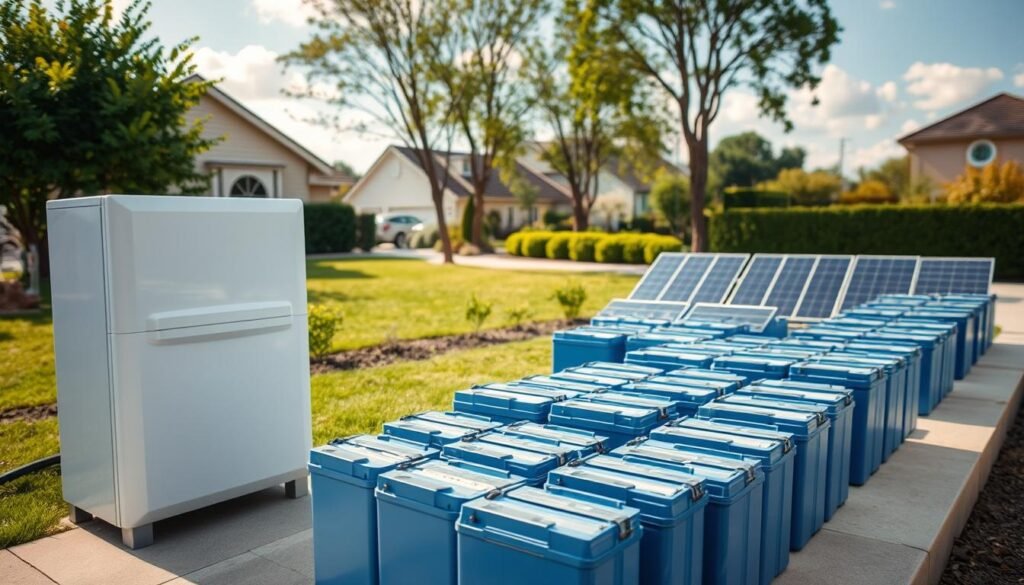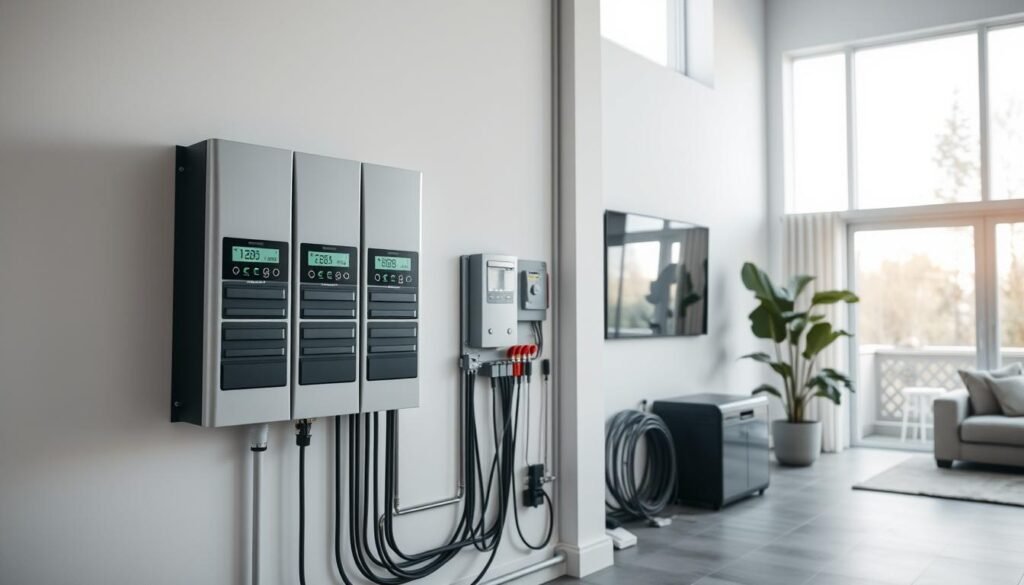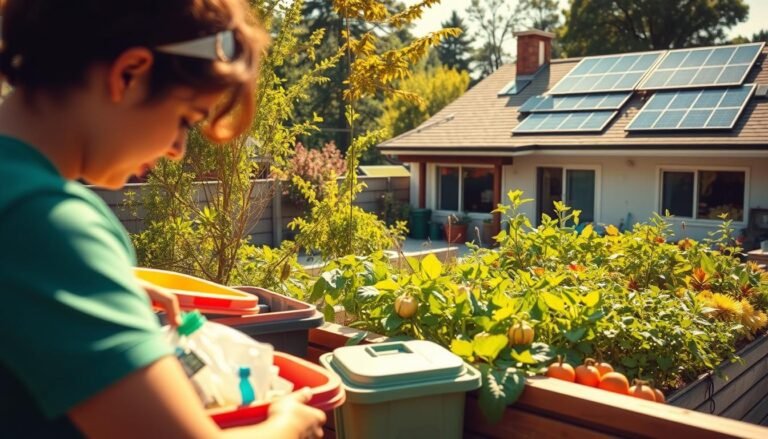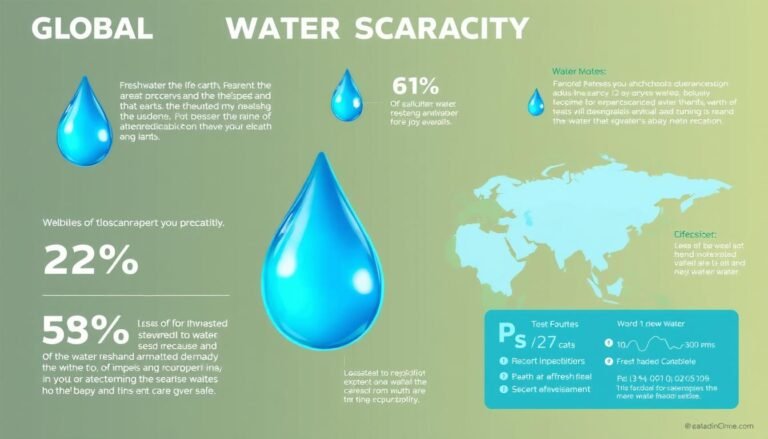As concerns about climate change and energy security continue to grow, Australian families are turning to sustainable energy solutions to lower their electricity bills and reduce their environmental footprint.
Reliable home energy storage is becoming increasingly important as it allows households to store excess energy generated from renewable sources, such as solar power.
By adopting solar energy storage systems, homeowners can reduce their reliance on the grid and save money on their energy bills.
A residential battery can store excess energy generated during the day for use at night, providing a reliable and efficient energy solution.
Key Takeaways
- Home energy storage allows households to store excess energy generated from renewable sources.
- Solar energy storage systems reduce reliance on the grid and save money on energy bills.
- A residential battery provides a reliable and efficient energy solution.
- Home energy storage promotes sustainability and reduces environmental footprint.
- Australian families can benefit from adopting home energy storage solutions.
The Growing Importance of Home Energy Storage in Australia
With rising energy costs and grid reliability concerns, Australian homeowners are turning to home energy storage solutions. The need for energy independence is becoming increasingly pressing as households seek to mitigate the impact of fluctuating energy prices and power outages.
Current Energy Challenges for Australian Homeowners
Australian households are facing significant energy challenges, primarily driven by rising electricity prices and grid reliability concerns.
Rising Electricity Prices
The cost of electricity in Australia has been increasing steadily, placing a significant burden on household budgets. Home energy storage systems offer a viable solution by enabling households to store excess energy generated from solar panels or other sources, reducing their reliance on the grid.
Grid Reliability Concerns
Australia’s energy grid is facing numerous challenges, including aging infrastructure and the impact of extreme weather events. This has resulted in power outages becoming more frequent, further emphasizing the need for home energy storage.
| Energy Challenge | Impact on Households | Role of Home Energy Storage |
|---|---|---|
| Rising Electricity Prices | Increased energy costs | Reduces reliance on the grid |
| Grid Reliability Concerns | Power outages and disruptions | Provides backup power during outages |
The Shift Towards Energy Independence
Home energy storage systems are pivotal in the shift towards energy independence. By storing energy generated from renewable sources, households can reduce their dependence on the grid, lower their energy bills, and contribute to a more sustainable energy future.
“As the world shifts towards more sustainable energy solutions, home energy storage is at the forefront of this revolution, empowering households to take control of their energy needs.”
Understanding Home-Energy-Storage Systems
As energy costs continue to rise, understanding home-energy-storage systems becomes increasingly important. Home energy storage systems allow homeowners to store excess energy generated by their solar panels or taken from the grid during off-peak hours, providing a reliable source of power during peak hours or power outages.
What Exactly is a Home Battery System?
A home battery system, also known as a home energy storage system, is designed to store electrical energy for later use. This is particularly useful for homes equipped with solar panels, as it allows them to store excess energy produced during the day for use at night or during periods of low sunlight.
The core component of a home battery system is the battery itself, which is typically made from advanced technologies such as lithium-ion. These batteries are designed to be efficient, durable, and safe, providing homeowners with a reliable means of storing energy.
How Energy Storage Integrates with Your Home
Integrating an energy storage system with your home involves connecting the battery system to your existing electrical infrastructure. This integration can be seamless, allowing your home to automatically switch between using stored energy, solar energy, and grid energy based on your needs and the availability of energy.
Basic Components and Setup
The basic components of a home energy storage system include the battery, an inverter to convert DC power to AC, and a control system to manage energy distribution. The setup involves installing these components in a suitable location, such as a garage or utility room, and connecting them to your home’s electrical panel.
Integration with Existing Electrical Systems
When integrating a home energy storage system with your existing electrical system, it’s crucial to ensure compatibility and safety. This often involves working with a professional installer who can assess your home’s electrical infrastructure and design a system that meets your energy needs.
| Component | Function |
|---|---|
| Battery | Stores electrical energy for later use |
| Inverter | Converts DC power to AC for home use |
| Control System | Manages energy distribution and system monitoring |
According to Renewable Energy World, “Home energy storage is becoming a critical component of the renewable energy landscape, enabling homeowners to maximize their energy independence and reduce reliance on the grid.”
Benefits of Installing Energy Storage for Your Home
Home energy storage systems provide a multitude of benefits for homeowners, ranging from significant financial savings to enhanced energy independence. By storing excess energy generated from solar panels or the grid during off-peak hours, homeowners can reduce their reliance on the grid during peak hours, thereby lowering their energy bills.
Financial Advantages
One of the most compelling reasons to install home energy storage is the potential for financial benefits. By reducing your reliance on the grid, you can lower your energy bills. Additionally, some energy storage systems can participate in virtual power plants, providing an opportunity to earn money by selling excess energy back to the grid.
Environmental Impact
The environmental impact of home energy storage is another significant advantage. By maximizing the use of renewable energy sources like solar power, homeowners can reduce their carbon footprint. Energy storage systems help stabilize the grid by storing excess energy generated from renewable sources, thereby supporting a cleaner environment.
Energy Security and Independence
Energy storage also enhances energy security and independence. During power outages, energy storage systems can provide backup power, ensuring that your home remains powered. This is particularly valuable in regions prone to natural disasters or with unreliable grid infrastructure.
Types of Residential Battery Technologies
The residential energy storage landscape is diverse, with several battery technologies available to homeowners. These technologies vary in their characteristics, advantages, and applications.

Lithium-Ion Batteries
Lithium-ion batteries are a popular choice for residential energy storage due to their high energy density and long cycle life. They are relatively compact and lightweight, making them suitable for home installations. Lithium-ion batteries also have a low self-discharge rate, meaning they retain their charge well when not in use.
Lead-Acid Batteries
Lead-acid batteries are another option for residential energy storage, known for their cost-effectiveness and reliability. While they have a lower energy density compared to lithium-ion batteries, they are still widely used, particularly in off-grid systems. Lead-acid batteries require regular maintenance to ensure optimal performance.
Flow Batteries and Emerging Technologies
Flow batteries, also known as vanadium redox batteries, offer a unique solution with their ability to store large amounts of energy. They are scalable and have a long duration discharge capability, making them suitable for homes with high energy demands. Emerging technologies, such as solid-state batteries, are also being developed, promising even greater efficiency and safety in the future.
Solar Energy Storage: The Perfect Partnership
Combining solar panels with energy storage systems is the key to maximizing energy self-consumption and reducing grid reliance. This synergy allows homeowners to optimize their energy usage, save on electricity bills, and contribute to a more sustainable environment.
How Solar and Battery Systems Work Together
Solar panels generate electricity during the day, which can be used immediately or stored in a battery for later use. This stored energy can then be utilized during peak hours or at night, reducing the need to draw electricity from the grid. By integrating solar and battery systems, homeowners can maximize their energy independence and enjoy a more reliable energy supply.
Maximising Solar Self-Consumption
Maximizing solar self-consumption is crucial for getting the most out of your solar energy system. By storing excess energy generated during the day, homeowners can use it during periods of high demand or when the sun is not shining.
Time-of-Use Optimisation
Time-of-use (TOU) optimisation is a significant benefit of solar energy storage. By storing energy when it’s cheap and using it during peak hours when electricity rates are higher, homeowners can significantly reduce their energy costs. For instance, charging your battery during off-peak hours and discharging it during peak hours can lead to substantial savings.
Seasonal Considerations for Australian Climate
Australia’s climate varies significantly across different regions and seasons. Solar energy storage systems can be optimized to account for these variations. For example, during summer months when energy consumption is higher due to air conditioning, a well-sized solar battery system can help reduce peak demand charges. Here are some key considerations:
- Assessing your energy usage patterns across different seasons.
- Sizing your solar battery system to meet your peak energy demands.
- Utilizing smart energy management systems to optimize energy storage and consumption.
By understanding these factors, homeowners can tailor their solar energy storage solutions to their specific needs, maximizing their energy savings and self-consumption.
Leading Home Energy Storage Solutions in Australia
With the growing importance of energy storage, several top brands are offering cutting-edge solutions for Australian homeowners. These innovative systems not only provide energy independence but also contribute to a sustainable future.
Tesla Powerwall
The Tesla Powerwall is a popular choice among Australian homeowners due to its high energy density and efficiency. It is designed to store excess energy generated by solar panels, allowing homeowners to use it during peak hours or power outages. The Tesla Powerwall is known for its seamless integration with solar systems and its ability to provide backup power during grid failures.
LG Chem RESU
LG Chem RESU is another highly regarded home energy storage solution in Australia. It offers flexible installation options and is compatible with a wide range of solar systems. The RESU series is praised for its high performance and reliability, making it a trusted choice for homeowners seeking to maximize their energy self-consumption.
Sonnen Battery
The Sonnen Battery is recognized for its intelligent energy management capabilities. It not only stores energy but also optimizes energy usage within the home. Sonnen’s innovative technology allows for real-time monitoring and control, ensuring that homeowners can manage their energy consumption efficiently.
BYD Battery Box
The BYD Battery Box is a robust home energy storage solution that offers high capacity and durability. It is designed to work in conjunction with solar systems, providing homeowners with a reliable source of energy. The BYD Battery Box is known for its safety features and long lifespan, making it a viable option for Australian homeowners.
In conclusion, these leading home energy storage solutions offer Australian homeowners a range of options to suit their energy needs. By choosing the right system, homeowners can enjoy financial savings, energy independence, and a reduced carbon footprint.
Sizing Your Home Energy Storage System
To get the most out of a home energy storage system, it’s essential to size it correctly for your household’s needs. Proper sizing ensures that the system operates efficiently and effectively, providing maximum benefits for Australian homeowners.
Assessing Your Household Energy Needs
Assessing your household’s energy needs is a crucial step in sizing your home energy storage system. This involves understanding your daily energy consumption patterns and peak usage times.
Calculating Daily Consumption
To calculate your daily consumption, review your past electricity bills or use a smart meter to monitor your energy usage. This data will help you determine the average amount of energy you need to store.
Peak Usage Analysis
Conducting a peak usage analysis will help you identify the times when your energy consumption is highest. This information is vital for sizing your energy storage system to meet your needs during peak periods.
Matching Battery Capacity to Consumption Patterns
Once you have assessed your energy needs, you can match your battery capacity to your consumption patterns. A well-sized battery system will ensure that you have enough stored energy to meet your needs, even during periods of high demand.
| Daily Consumption (kWh) | Recommended Battery Capacity (kWh) | System Cost Estimate ($) |
|---|---|---|
| 10-15 | 10-12 | 8,000-12,000 |
| 15-20 | 14-16 | 10,000-15,000 |
| 20-25 | 18-20 | 14,000-18,000 |
Installation Process and Requirements
Home energy storage installation in Australia requires careful planning and compliance with local regulations. The process involves several critical steps to ensure that the system operates efficiently and safely.
Site Assessment and System Design
A thorough site assessment is essential to determine the most suitable home energy storage solution for your household. This assessment considers factors such as your energy consumption patterns, available space for the battery system, and the condition of your existing solar panel installation, if applicable. Professional installers will design a system that meets your specific needs, ensuring optimal performance and safety.

Permits and Regulations in Australia
Compliance with Australian regulations is a critical aspect of home energy storage installation. Homeowners must adhere to guidelines set by the Clean Energy Council and state-specific requirements.
Clean Energy Council Guidelines
The Clean Energy Council provides accreditation for installers and sets standards for the installation of renewable energy systems, including home energy storage. Ensuring that your installer is accredited and follows these guidelines is crucial for the validity of your system’s warranty and safety.
State-Specific Requirements
Australia’s states and territories may have additional regulations regarding the installation of home energy storage systems. For example, some states require specific electrical certifications or have different rules regarding grid connection. It’s essential to consult with local authorities or a professional installer to understand the specific requirements in your area.
Professional vs DIY Installation Considerations
While DIY installation might seem like a cost-effective option, professional installation is generally recommended for home energy storage systems. Professionals can ensure that the system is designed and installed correctly, maximizing efficiency and safety. They are also familiar with local regulations and can handle any necessary paperwork.
| Installation Aspect | Professional Installation | DIY Installation |
|---|---|---|
| Cost | Higher upfront cost | Potential savings on labor |
| Safety and Compliance | Ensures compliance with regulations and safety standards | Risk of non-compliance and safety hazards |
| Expertise | Installers have specialized knowledge and experience | Requires homeowner to have technical knowledge |
Cost Analysis of Home Energy Storage
Understanding the financial implications of home energy storage is crucial for Australian homeowners looking to invest in sustainable energy solutions. A comprehensive cost analysis involves evaluating the initial investment, ongoing maintenance costs, and potential return on investment.
Initial Investment Breakdown
The initial cost of a home energy storage system includes the price of the battery, installation costs, and any additional hardware required. For instance, the cost of lithium-ion batteries, a popular choice for home energy storage, can vary significantly based on capacity and brand. According to recent data, the average cost for a residential battery system in Australia ranges from $5,000 to $15,000 or more, depending on the system’s size and complexity.
Ongoing Maintenance Costs
Ongoing maintenance costs for home energy storage systems are generally minimal, as most modern battery systems are designed to be durable and require little upkeep. However, there may be costs associated with monitoring and potentially replacing the system after its warranty period, typically ranging from 10 to 15 years. It’s essential to factor these costs into your overall cost analysis to get a true picture of the system’s long-term financial implications.
Return on Investment Calculations
Calculating the return on investment (ROI) for a home energy storage system involves assessing how much you save on your energy bills and potentially earning credits through feed-in tariffs. For an accurate ROI calculation, consider factors like your energy usage patterns, the system’s efficiency, and local electricity rates. You can refer to detailed resources such as residential battery storage analysis to understand the financial benefits better.
Payback Period Estimates
The payback period for a home energy storage system varies widely depending on the initial cost, your energy savings, and any incentives you might receive. Generally, homeowners can expect a payback period ranging from 5 to 10 years, although this can be shorter with the right combination of solar panels and energy storage.
Long-term Financial Benefits
Beyond the payback period, home energy storage systems can continue to provide financial benefits by reducing your reliance on the grid and lowering your energy bills. Over the system’s lifetime, these savings can add up, providing a significant return on your initial investment. Moreover, as energy prices continue to rise, the value of having a stored energy supply will only increase, enhancing the long-term financial benefits of such systems.
Australian Government Incentives and Rebates
The Australian government offers various incentives to encourage the adoption of home energy storage systems. These incentives are designed to make the transition to renewable energy more financially viable for homeowners.
Federal Support Programs
The federal government provides support through various initiatives, although specific programs may vary. One of the key federal incentives is the tax offset for solar and battery systems, which can help reduce the upfront cost.
State-Specific Incentives
Different states in Australia offer unique incentives to promote home energy storage. Some of the notable programs include:
NSW Empowering Homes Program
This program offers interest-free loans for eligible solar battery systems, making it more affordable for NSW residents to adopt home energy storage.
Victoria’s Solar Homes Program
Victoria’s program provides rebates for solar battery systems, encouraging homeowners to invest in energy storage and reduce their reliance on the grid.
South Australia Home Battery Scheme
South Australia offers subsidies for eligible home battery systems, helping residents to store excess energy generated from their solar panels.
| State | Program Name | Incentive Type |
|---|---|---|
| NSW | Empowering Homes | Interest-Free Loans |
| Victoria | Solar Homes | Rebates |
| South Australia | Home Battery Scheme | Subsidies |
How to Apply for Available Rebates
To apply for these rebates, homeowners should visit the relevant state government’s energy website, check eligibility criteria, and follow the application process. It’s also advisable to consult with a certified installer who can guide you through the process.
Smart Energy Management Systems
Effective energy management is key to getting the most out of home energy storage, and smart systems are leading the way. Smart energy management systems can significantly enhance the efficiency and effectiveness of home energy storage.
Monitoring Your Energy Production and Usage
To optimize energy storage, it’s crucial to monitor both energy production and usage. This is where energy monitoring platforms come into play.
Popular Energy Monitoring Platforms in Australia
Some of the popular energy monitoring platforms in Australia include OpenHAB and Home Assistant. These platforms provide detailed insights into energy consumption patterns.
Understanding Energy Analytics
Energy analytics help homeowners understand their energy usage patterns, enabling them to make informed decisions about their energy storage and consumption.
Automated Energy Optimisation Technologies
Automated energy optimisation technologies take energy management to the next level by adjusting energy usage in real-time based on energy availability and consumption patterns. This not only maximizes the use of stored energy but also helps in reducing energy bills.
By integrating smart energy management systems with home energy storage, homeowners can achieve a more sustainable and cost-effective energy solution.
Integrating with the Australian Electricity Grid
As Australia continues to embrace renewable energy, integrating home energy storage with the national electricity grid has become increasingly important. This integration not only enhances the efficiency of renewable energy sources but also provides homeowners with additional financial benefits and energy security.
Feed-in Tariffs and Virtual Power Plants
Home energy storage systems can interact with the grid through mechanisms like feed-in tariffs and virtual power plants (VPPs). Feed-in tariffs allow homeowners to sell excess energy back to the grid, offsetting their energy bills. Virtual Power Plants, on the other hand, aggregate multiple home energy storage systems to provide grid stability and reliability. By participating in VPPs, homeowners can receive financial incentives for contributing to grid stability.
Grid Support and Demand Response Programs
Home energy storage systems also play a crucial role in grid support and demand response programs. These programs help balance energy supply and demand, particularly during peak periods. Homeowners with energy storage systems can benefit from participating in demand response programs by receiving payments for reducing their energy consumption when the grid is under strain.
Energy Arbitrage Opportunities
Energy arbitrage is another benefit of home energy storage integration with the grid. Homeowners can charge their batteries during off-peak hours when electricity is cheaper and discharge it during peak hours when electricity is more expensive, thereby saving on their energy bills.
Participating in Grid Stabilisation
By participating in grid stabilisation efforts, homeowners can contribute to the overall reliability of the electricity grid. This not only benefits the grid but also provides homeowners with potential financial rewards through various incentive programs.
Real-Life Case Studies from Australian Homes
Real-life examples from across Australia showcase the transformative impact of home energy storage on residential energy consumption. Homeowners across the country are embracing energy storage solutions to reduce their reliance on the grid and lower their energy bills.
Urban Home Energy Transformation in Sydney
In Sydney, a typical urban home was able to significantly reduce its energy bills by installing a Tesla Powerwall battery system alongside its existing solar panels. The system allows the homeowners to store excess energy generated during the day for use at night, reducing their reliance on the grid and lowering their energy bills.
The homeowners reported a noticeable decrease in their energy expenses, with savings averaging around 30% per annum. This transformation not only benefited the homeowners financially but also contributed to a reduction in the household’s carbon footprint.
Rural Property Energy Independence in Queensland
A rural property in Queensland achieved energy independence with the installation of a Sonnen battery system. The system was designed to meet the property’s specific energy needs, allowing the owners to power their home entirely off-grid.
The property owners highlighted the peace of mind that comes with knowing they are not reliant on the grid, especially during periods of extreme weather when power outages are common. The energy independence achieved through the home energy storage system has been a game-changer for this rural household.
Future of Home Energy Storage Technology
Advancements in home energy storage are set to transform the way we consume energy. As technology continues to evolve, we can expect significant improvements in how energy is stored and utilized in homes across Australia.
Upcoming Innovations in Battery Technology
The future of home energy storage is heavily reliant on advancements in battery technology. Innovations such as solid-state batteries and lithium-air batteries are expected to play a crucial role. These advancements promise to enhance energy density, reduce costs, and improve safety.
Predicted Cost Trends and Accessibility
As battery technology improves, the cost of home energy storage systems is predicted to decrease, making them more accessible to a wider audience. This trend is expected to continue, driven by economies of scale and technological advancements.
Price Projections for Australian Market
Industry forecasts suggest that the cost of home energy storage will drop significantly over the next decade, making it more competitive with traditional energy sources.
Mass Adoption Timeline
With decreasing costs and improving technology, the mass adoption of home energy storage systems in Australia is expected to accelerate. This shift will be supported by government incentives and growing environmental awareness.
The future of home energy storage looks promising, with ongoing innovations set to make it more efficient, affordable, and accessible. As we move towards a more sustainable energy future, home energy storage will play a pivotal role.
Common Challenges and How to Overcome Them
As the popularity of home energy storage grows in Australia, so does the need to understand and overcome the associated technical and efficiency challenges. Homeowners who invest in energy storage systems often face a range of issues that can impact the overall performance and longevity of their systems.
Technical Issues and Troubleshooting
Technical issues can arise from various sources, including installation problems, battery health, and compatibility with existing solar systems. Troubleshooting these issues often requires a systematic approach, starting with monitoring system performance and identifying error messages or unusual behavior.
- Check the system’s monitoring app for error messages or alerts.
- Ensure that the system is properly configured and installed according to the manufacturer’s instructions.
- Regularly update software and firmware to the latest versions.
For more complex issues, consulting with a professional installer or the manufacturer’s technical support team is advisable.
Maximising System Efficiency Over Time
Maximising the efficiency of a home energy storage system involves both initial setup and ongoing maintenance. Proper system efficiency ensures that homeowners get the most out of their investment.
Maintenance Best Practices
Regular maintenance is crucial for the longevity and efficiency of energy storage systems. This includes:
- Regularly inspecting the system for signs of wear or damage.
- Keeping the battery and other components clean and free from debris.
- Monitoring system performance and adjusting settings as needed.
When to Consider System Upgrades
Over time, the needs of homeowners may change, or technology may advance, making a system upgrade necessary. Signs that an upgrade might be needed include:
| Indicator | Description |
|---|---|
| Reduced System Performance | If the system is not holding charge as well as it used to, or if there’s a noticeable decrease in efficiency. |
| New Technology Availability | Advancements in battery technology or other components that could significantly improve system performance or efficiency. |
| Changing Energy Needs | If the household’s energy needs have changed due to additions like new appliances or electric vehicles. |
As noted by energy expert,
“The future of home energy storage is not just about the technology itself, but how we use it to create a more sustainable and resilient energy system.”
By understanding the common challenges associated with home energy storage and implementing strategies to overcome them, Australian homeowners can maximise the benefits of their energy storage systems, contributing to a more sustainable energy future.
Conclusion: Powering Australian Homes Sustainably
Australian homeowners are increasingly turning to home energy storage to power their homes sustainably. By harnessing the power of sustainable energy, households can reduce their reliance on the grid and lower their carbon footprint.
Home energy storage systems, particularly when paired with solar energy, offer a reliable and efficient way to achieve energy independence. With various battery technologies available, such as lithium-ion and lead-acid batteries, homeowners can choose the best solution for their needs.
As the Australian energy landscape continues to evolve, the importance of home energy storage will only continue to grow. By investing in a home energy storage system, homeowners can not only save money but also contribute to a more sustainable energy future.





